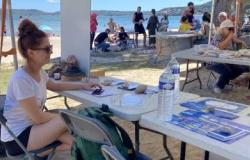Before each election, it has become a tradition. The results of the first round of the legislative elections are barely known when we see projections in the number of seats of the future composition of the National Assembly blooming in the media and on social networks.
Ifop, Ipsos, Elabe, Opinionway, the different polling institutes have each published their projection of the distribution of seats in the hemicycle, commissioned by different media.
The National Rally (RN) and its allies would obtain between 230 and 280 seats on the Radio France side. Figarothe final results of the RN would be between 240 and 270. A range which rises between 255 and 295 at BFMTV, where the far-right party could therefore obtain the absolute majority (more than 289 seats).
Regarding the New Popular Front, estimates range between 125 and 165 seats on the public service side, but rather between 180 and 200 on the Figaroand between 120 and 140 on BFMTV. As the media themselves sometimes point out, these projections must nevertheless be taken with (a lot of) tweezers.
It is difficult to take into account the situation of each constituency.
The projections are made from the results of a set of polling stations considered representative. “These local results, which form an “overall report”, are scrutinized by an algorithm which takes into account, in particular, the results of previous legislative elections”, explains for example Le Figaro about the methodology of its survey carried out by Ifop-Fiducial. Different projections are then made which take into account different scenarios for the second round (depending on the triangulars, for example).
A limit is quickly emerging, however. At this time, that is to say before the deadline for submitting candidacies (this Tuesday 6 p.m.), it is difficult to predict with exactitude the situations for each constituency. For example, we do not yet know precisely all the cases of withdrawals, which vary according to the voting instructions, which are also not taken into account. Jean-Luc Mélenchon, for example, indicated on Sunday evening that La France insoumise (LFI) “will withdraw” its candidacies in the constituencies where it came in third place and where the RN is first. Prime Minister Gabriel Attal, for his part, made it known that “not a single vote should go to the National Rally.”
“It is very random and the methodology is quite fragile until we have the final results and the final offer in each constituency,” summarizes in Le Figaro François Kraus, director of the Politics and News department at Ifop.
Surprises in previous legislative elections
In fact, the low reliability of these projections has already proven itself during previous legislative elections. In 2022, for example, the Ipsos-Sopra Steria poll for France Télévisions, Radio France, France Médias Monde and the parliamentary channels gave between 20 and 45 seats to the National Rally, and between 255 and 295 for the presidential party Ensemble!. Another estimate by Ifop gave the National Rally between 5 and 25 seats, and between 270 and 310 seats to the presidential majority. Estimates that are ultimately far from the actual results, where the far-right party will win 89 deputies, and the majority only 245.
A few years earlier, in 2017, we could also cite the example of the Elabe poll for BFMTV, giving between 395 and 425 seats to the LREM, which ultimately obtained 308.





